Rainforests are truly awesome. The rainforests of the world cover between two and six percent of the Earth’s surface, yet they’re home to more than 50% of the globe’s known plant and animal species. This level of biodiversity isn’t found in any other ecosystem.
In this guide, we’ll travel through four major rainforests of the world and some smaller rainforest regions, from South America to Asia. Discover the unique traits of each, why they’re at risk, and why protection efforts are so important. At Remitly, we know it’ll take all of us to keep these vital areas thriving.
A critically important part of nature’s balance
Rainforests are carbon sinks, meaning they literally help supply the air we breathe by absorbing more carbon dioxide than they emit, helping to slow climate change. They also help maintain the water cycle, are the sources of important foods like bananas and cocoa, and house countless medicinal plants. And that’s not to mention the habitat they provide for a huge number of animals.
However, in the 20 years from 2001 to 2020, the Amazon alone lost more than 133 million acres—about nine percent of its previous total area. And it’s not the only one suffering—rainforests around the world face similar threats. So let’s take a look at some of these “lungs of the Earth” worldwide.
The Amazon rainforest: biodiversity at its finest
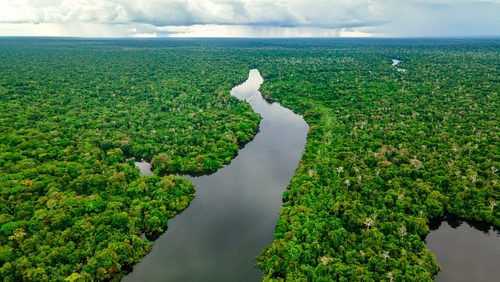
We’ll stay with the Amazon to start, because nothing else really compares to it. It covers over 2.5 million square miles across South America. The biggest concentration is in Brazil, but it’s also in Bolivia, Colombia, Ecuador, Guyana, Peru, Suriname, Venezuela and French Guiana.
Aside from covering a vast area, the Amazon’s biodiversity is astounding. We’re talking about more than 400 billion trees and 10% of the world’s known species.
The Amazon does more than house plants and animals—it actually influences the weather. The term “flying rivers” was coined to convey the huge amount of water held in the clouds above the Amazonian tree canopy.
The moisture that’s released by those billions of trees goes into the atmosphere, and clouds then carry it to fuel rainfall all over South America. This phenomenon influences weather patterns as far away as the US and even Africa.
Largest Amazon rainforest threats
The Amazon’s survival is up against severe threats. Illegal logging, cattle ranching, deforestation for development, and agricultural expansion are destroying parcels of land bit by bit.
Stored carbon is released when trees are cut down, and with fewer trees, the rainforest can’t absorb as much oxygen or generate the same amount of rainfall, which has consequences across the continent and even beyond. Plus, every acre lost is one that animals and plants can’t use to sustain themselves.
But all is not lost. Local communities, Indigenous people who have lived in harmony with rainforests for millennia, and global scientists are leading the campaign to do something about the rainforest losses.
- Indigenous land rights recognition
Amazon countries, like Brazil, Colombia, and Peru, are legally recognizing Indigenous territories. On Indigenous land, deforestation is less than 1%, compared to more than 7% in the Amazon as a whole. - Brazil’s DETER system
This satellite system allows for real-time monitoring of forest loss and guides law enforcement to targeted areas. Deforestation alerts decreased by 24% between 2023 and 2024. - The Amazon Fund
Developed by the Brazilian government to encourage financial support, this initiative’s goals are sustainable development, reforestation, and enforcement. In all, they’ve funded over 100 projects.
Congo Basin: the world’s second-largest rainforest
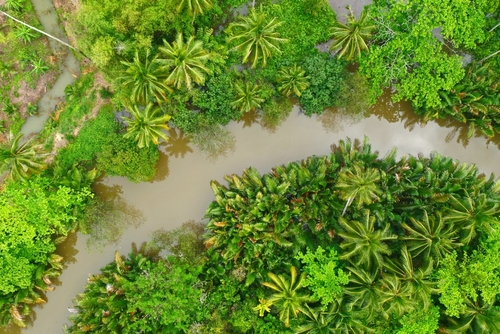
This area is full of second-place finishes: it’s the second-largest rainforest in the world after the Amazon, and the Congo River is the second-largest by volume in the world, again after the Amazon River.
Sometimes called Africa’s beating heart, the Congo Basin covers approximately 700,000 square miles, also spread over nine countries. But there are six countries with the largest tree cover that are officially considered part of the Congo Basin rainforest:
- Cameroon—a large portion of forest is in the Sanaga River Basin
- The Central African Republic
- The Republic of Congo—some in the Ogooue River Basin
- Democratic Republic of the Congo (DRC)
- Equatorial Guinea
- Gabon—mostly in the Ogooue River Basin
The DRC has the largest share of the Congo Basin rainforest at over 240 million acres.
Like the Amazon rainforest, the Congo Basin absorbs billions of tons of carbon dioxide every year. It also regulates rainfall across Southern Africa, which local communities rely on for drinking and farming.
Animals of the Congo Basin rainforest
Biodiversity is king here, with the iconic animals like mountain and lowland gorillas living in the Congo Basin rainforest.
It’s also home to bonobos—smaller than chimpanzees but closely related to them, majestic forest elephants, and the so-called “forest giraffe,” the okapi. As many as 1,000 different bird species fly through the Congo Basin’s treetops.
Threats to the Congo Basin rainforest
Everything from political instability in the region and weak enforcement policies to poverty puts this rainforest at risk. Illegal mining and the bushmeat trade are, unfortunately, sometimes among the limited opportunities locals have to support their families.
To combat these threats, community-led conservation, eco-tourism, and anti-poaching patrols are showing promise. For example, the DRC is expanding protected areas for bonobos and forest elephants. A good example is Lomami National Park, created in 2017 for animals to continue roaming free.
Southeast Asian rainforests: ancient diversity under threat
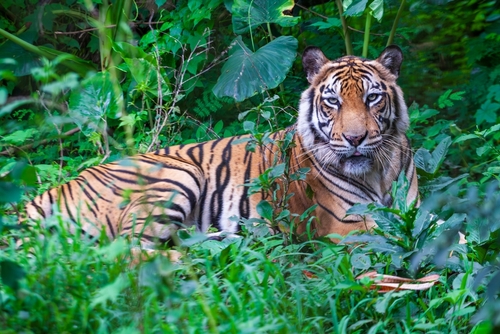
Southeast Asia’s rainforests, in countries like Indonesia and Malaysia, are some of the oldest in the world; they’re more than 130 million years old and predate the Amazon.
Incredible biodiversity
Take a trip to the tropical forests here, and you might be lucky enough to see orangutans swinging through the trees or the elusive Sumatran tiger. These forest ecosystems contain thousands of endemic plants and even the world’s smallest rhino–the Sumatran rhinoceros—which has been labeled as critically endangered since 1996.
Have you ever seen a Dipterocarp tree? At maturity, they can reach 200 feet high. They’re found throughout Southeast Asia, with a significant concentration in Borneo, but a study has found that 62% of dipterocarp species are at risk of extinction.
The most common threats
The ancient biodiversity in Southeast Asia is at risk. Palm oil plantations drive deforestation, which is particularly harmful to orangutan habitats. Rapid urbanization is also a threat, as is logging.
Southeast Asian rainforest success stories
Since palm oil plantations are a big concern in the region, the Roundtable on Sustainable Palm Oil (RSPO) Certification encourages companies to only source palm oil from responsible and sustainable farmers. In 2023, 19% of palm oil was RPSO-certified, so at least there’s some progress being made there.
Organizations are also helping to rehabilitate and release orangutans into the wild. In Indonesia, the Nyaru Menteng Orangutan Project is working hard to save the species by rescuing, caring for and releasing orphaned, injured, or habitat-less orangs into protected areas.
Temperate rainforests: the forgotten giants
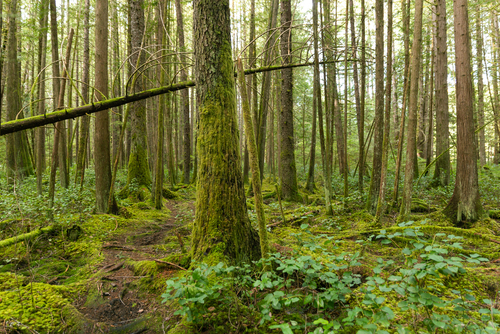
When you think of rainforests, you’re probably thinking of the tropics. But we can’t forget about the temperate forests of places like the Pacific Northwest of North America, southern Chile, and Tasmania. They’re really important ecosystems too.
Temperate climate rainforests thrive in cooler, coastal climates with relatively mild temperatures and lots of rainfall. One clear difference between temperate and tropical rainforests is scale; the Douglas fir trees of British Columbia, Canada, for example, reach heights of 330 feet, and some are more than 1,000 years old.
That’s impressive, but in Chile a thousand years is less than half the story. The Gran Abuelo tree from the cypress family in Alerce Costero National Park is thought to be over 5,000 years old!
Smaller rainforest regions: lesser-known gems worth protecting
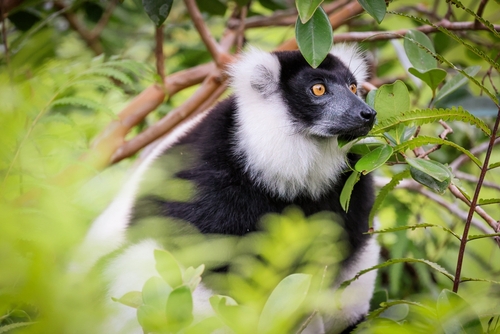
While the larger rainforests are getting all the attention, the smaller ones still have a lot to offer in terms of biodiversity, and their role in nature shouldn’t be underestimated.
Madagascar: an island of unique life
Off the Southeastern coast of Africa, this island’s rainforests are simply extraordinary. Up to 90% of the species here aren’t found anywhere else. So, if they lose this precious habitat, our world loses:
- Around 100 species of lemurs.
- About half the world’s chameleon species.
- Tenrecs—small, hedgehog-like animals.
- Countless butterflies, spiders, and insects.
Madagascar’s rainforests are under threat from charcoal production and slash-and-burn agriculture. It’s estimated that the forest cover in Madagascar decreased by almost 40% in the second half of the twentieth century.
Central America’s cloud forests
In Central America, the high-altitude cloud forests like Monteverde Cloud Forest Reserve in Costa Rica are enchanting but fragile forest ecosystems. The trees grow on mountain slopes where warm air rises and cools. They get their name from the near-constant mist that shrouds the forest.
This abundant and almost constant moisture makes them lush, with moss, lichens, and orchids growing over every branch and trunk. Like Madagascar, there are some extremely rare species in these forests. You’ll find everything from the quetzal, a bird sacred to ancient Mayan civilizations, to threatened salamanders, along with many species found nowhere else on Earth.
Rainforests in Australia
Australia’s remaining rainforest fragments include the Daintree in Queensland and small patches in Tasmania. Though they’re modest in size, these forests pack a big environmental punch and are intrinsically linked with Aboriginal traditions and culture.
For example, the Daintree alone contains over 3,000 plant species, including primitive flowering plants found nowhere else. It therefore provides some clues as to the very origins of modern plants.
Unique animals thrive here, too. The endangered southern cassowary, a very large, flightless bird often called the “guardian of the rainforest,” plays an important role in seed dispersal. Tree kangaroos, rare possums, and colorful butterflies make the entire region ecologically rich.
The ripple effect: how rainforest loss affects everyone
Rainforests of the world aren’t just stunning to look at and home to many of our rarest plants and animals. They’re also climate stabilizers, cultural homes, and rainfall gatekeepers. Lose our rainforests, and we get:
- Accelerated global warming
When we clear or burn our rainforests, the stored carbon is released into the atmosphere as CO₂ and contributes to global warming. - Less evapotranspiration
This is the scientific term for the way trees release moisture into the atmosphere, fueling clouds and cooling the air. The result without it? Hotter and drier conditions. - A worldwide weather pattern shift
Moisture from rainforests travels thousands of miles, affecting rainfall levels across large areas. - Loss of medicinal plants
We lose the potential for medical advances that emerge from research into rainforest plants and organisms. - Lost homes
Indigenous people lose their homelands, and animals lose the ecosystems they need for survival.
Safeguarding the rainforests of the world—together
The rainforests of the world play a key role in keeping our climate stable. From sustaining biodiversity to influencing rainfall and providing homes for indigenous communities, they’re environmental powerhouses and we need them. So it’s more important than ever to conserve what we have left—and thankfully both science and millions of consumers have woken up to that fact.
Shop responsibly, contribute to reputable rainforest-related causes like the WWF or the Rainforest Trust, and look for eco-tourism options for your next trip. If we work together, we can transform rainforest losses into gains for future generations.
FAQs
Which is the largest rainforest?
By any metric, whether it’s the number and variety of trees, animal species, or land area, the Amazon rainforest is the largest in the world.
How can I help protect rainforests?
There are steps individuals can take to protect our rainforests. Opt for a forest-friendly diet that’s low in red meat and not based on rainforest-clearing agriculture. Look for certified, responsibly sourced products, and most of all, get the word out. Donate, join causes, and tell your friends.
How many rainforests are there in the world?
They’re found in over 50 countries worldwide, with around 40 major rainforests globally.